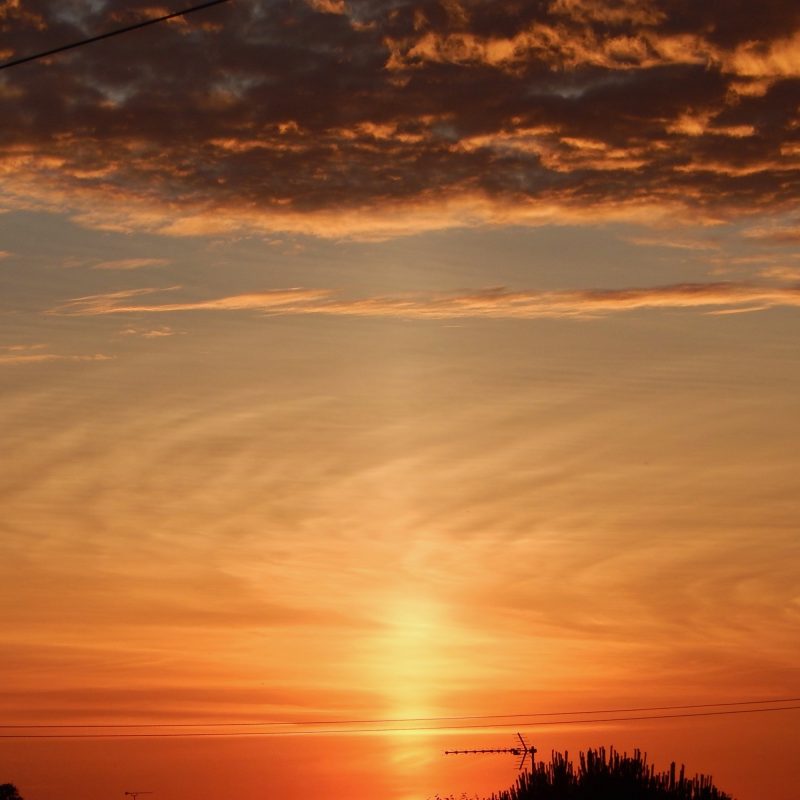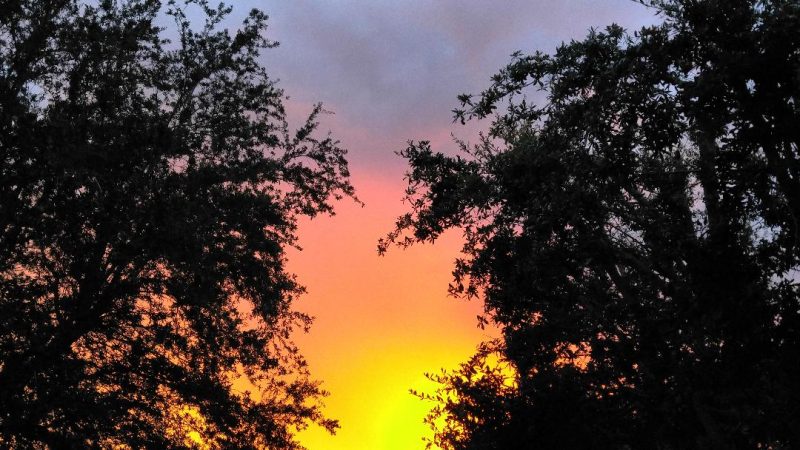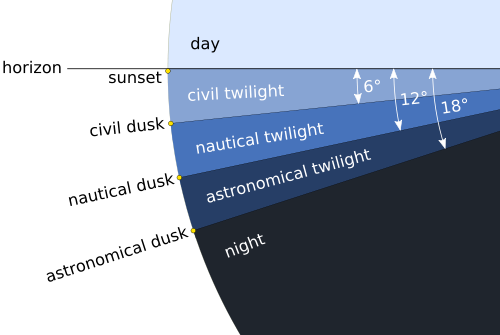
Latest sunsets after summer solstice
For the Northern Hemisphere: Your latest sunsets – and latest evening twilights – are happening around now. They always come in late June and early July. Meanwhile, the Northern Hemisphere’s longest day fell on the June 20-21 solstice.
For 40 degrees north (Philadelphia, Pennsylvania; just north of Denver, Colorado; Beijing, China; Turkey; Japan and Spain), the latest sunsets are centered around June 27. The year’s latest sunsets always come after the summer solstice. But the exact date of the latest sunset depends on your latitude. Farther north – at Seattle – the latest sunsets happen on dates centered on June 25.
Farther south – at Mexico City or Hawaii – the latest sunset are centered on dates in early July.
For the Southern Hemisphere: Your latest sunrises of the year happen in late June and early July.
For the Northern or Southern Hemispheres: Latest sunsets go hand-in-hand with your latest twilights. The latest twilights of the year for 40 degrees north also happen in late June and early July. More about twilight below.
Visit Sunrise Sunset Calendars.

Why latest sunsets follow summer solstice
The latest sunsets comes after the summer solstice because the day is more than 24 hours long at this time of the year.
For several weeks, around the June solstice, the day (as measured by successive returns of the midday sun) is nearly 1/4 minute longer than 24 hours. Hence, the midday sun (solar noon) comes later by the clock in late June than it does on the June solstice. Therefore, the sunrise and sunset times also come later by the clock, as the table below helps to explain.
For Denver, Colorado
| Date | Sunrise | Midday (Solar Noon) | Sunset | Daylight Hours |
| June 20 | 5:32 a.m. | 1:01 p.m. | 8:31 p.m. | 14h 59m 15s |
| June 27 | 5:34 a.m. | 1:03 p.m. | 8:32 p.m. | 14h 57m 57s |
Source: timeanddate.com

Clock time and sun time
If the Earth’s axis stood upright as our world circled the sun, and if, in addition, the Earth stayed the same distance from the sun all year long, then clock time and sun time would always agree.
However, the Earth’s axis is titled 23.44 degrees out of vertical, and our distance from the sun varies by about 3 million miles (5 million km) throughout the year. At and around the equinoxes, solar days are shorter than 24 hours, yet at the solstices, solar days are longer than 24 hours.
That’s why the latest sunsets always come on or near June 27 at mid-northern latitudes every year.
At mid-northern latitudes, the later clock time for solar noon one week after the summer solstice is more substantial than the change in daylight hours. Given that the daylight hours on June 27 are almost the same as they were on the June 20-21 solstice, the later clock time for the June 27 solar noon gives us slightly later sunrise and sunset times, as well
A word about twilight
There are three kinds of twilight:
Civil twilight starts at sundown and ends when the sun is 6 degrees below the horizon.
Nautical twilight occurs when the sun is 6 to 12 degrees below the horizon.
Astronomical twilight happens when the sun is 12 to 18 degrees below the horizon.
North of 50 degrees north latitude, there’s no true night in the month of June. In June, that far north, the sun never gets far enough below the horizon for true night to occur. So for 50 degrees north latitude – to the Arctic Circle (66.5 degrees north latitude) – you’ll find midnight twilight at this time of year.
And, above the Arctic Circle to the North Pole (90 degrees north latitude), this time of year is the time of the midnight sun.
Read more: What exactly is twilight?

Bottom line: Why don’t the latest sunsets come on the longest day (the solstice)? In a nutshell, it’s a discrepancy between the sun and the clock. Thus, for mid-northern latitudes, the latest sunsets always come in late June.
Enjoying EarthSky so far? Sign up for our free daily newsletter
Donate: Your support means the world to us
The post Latest sunsets follow summer solstice first appeared on EarthSky.
from EarthSky https://ift.tt/3gXatLz

Latest sunsets after summer solstice
For the Northern Hemisphere: Your latest sunsets – and latest evening twilights – are happening around now. They always come in late June and early July. Meanwhile, the Northern Hemisphere’s longest day fell on the June 20-21 solstice.
For 40 degrees north (Philadelphia, Pennsylvania; just north of Denver, Colorado; Beijing, China; Turkey; Japan and Spain), the latest sunsets are centered around June 27. The year’s latest sunsets always come after the summer solstice. But the exact date of the latest sunset depends on your latitude. Farther north – at Seattle – the latest sunsets happen on dates centered on June 25.
Farther south – at Mexico City or Hawaii – the latest sunset are centered on dates in early July.
For the Southern Hemisphere: Your latest sunrises of the year happen in late June and early July.
For the Northern or Southern Hemispheres: Latest sunsets go hand-in-hand with your latest twilights. The latest twilights of the year for 40 degrees north also happen in late June and early July. More about twilight below.
Visit Sunrise Sunset Calendars.

Why latest sunsets follow summer solstice
The latest sunsets comes after the summer solstice because the day is more than 24 hours long at this time of the year.
For several weeks, around the June solstice, the day (as measured by successive returns of the midday sun) is nearly 1/4 minute longer than 24 hours. Hence, the midday sun (solar noon) comes later by the clock in late June than it does on the June solstice. Therefore, the sunrise and sunset times also come later by the clock, as the table below helps to explain.
For Denver, Colorado
| Date | Sunrise | Midday (Solar Noon) | Sunset | Daylight Hours |
| June 20 | 5:32 a.m. | 1:01 p.m. | 8:31 p.m. | 14h 59m 15s |
| June 27 | 5:34 a.m. | 1:03 p.m. | 8:32 p.m. | 14h 57m 57s |
Source: timeanddate.com

Clock time and sun time
If the Earth’s axis stood upright as our world circled the sun, and if, in addition, the Earth stayed the same distance from the sun all year long, then clock time and sun time would always agree.
However, the Earth’s axis is titled 23.44 degrees out of vertical, and our distance from the sun varies by about 3 million miles (5 million km) throughout the year. At and around the equinoxes, solar days are shorter than 24 hours, yet at the solstices, solar days are longer than 24 hours.
That’s why the latest sunsets always come on or near June 27 at mid-northern latitudes every year.
At mid-northern latitudes, the later clock time for solar noon one week after the summer solstice is more substantial than the change in daylight hours. Given that the daylight hours on June 27 are almost the same as they were on the June 20-21 solstice, the later clock time for the June 27 solar noon gives us slightly later sunrise and sunset times, as well
A word about twilight
There are three kinds of twilight:
Civil twilight starts at sundown and ends when the sun is 6 degrees below the horizon.
Nautical twilight occurs when the sun is 6 to 12 degrees below the horizon.
Astronomical twilight happens when the sun is 12 to 18 degrees below the horizon.
North of 50 degrees north latitude, there’s no true night in the month of June. In June, that far north, the sun never gets far enough below the horizon for true night to occur. So for 50 degrees north latitude – to the Arctic Circle (66.5 degrees north latitude) – you’ll find midnight twilight at this time of year.
And, above the Arctic Circle to the North Pole (90 degrees north latitude), this time of year is the time of the midnight sun.
Read more: What exactly is twilight?

Bottom line: Why don’t the latest sunsets come on the longest day (the solstice)? In a nutshell, it’s a discrepancy between the sun and the clock. Thus, for mid-northern latitudes, the latest sunsets always come in late June.
Enjoying EarthSky so far? Sign up for our free daily newsletter
Donate: Your support means the world to us
The post Latest sunsets follow summer solstice first appeared on EarthSky.
from EarthSky https://ift.tt/3gXatLz

Aucun commentaire:
Enregistrer un commentaire